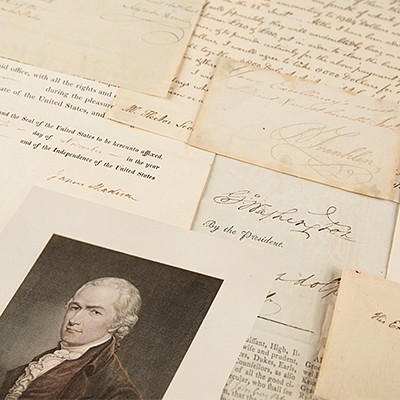Anton von Webern Content-Rich Autograph Letter Signed, Offering a Detailed History of His Musical Career and His Association with Arnold Schoenberg
Two ways to bid:
- Leave a max absentee bid and the platform will bid on your behalf up to your maximum bid during the live auction.
- Bid live during the auction and your bids will be submitted real-time to the auctioneer.
Bid Increments
| Price | Bid Increment |
|---|---|
| $0 | $5 |
| $50 | $10 |
| $200 | $25 |
| $500 | $50 |
About Auction
Oct 11, 2023
RR Auction support@rrauction.com
- Lot Description
Austrian composer and conductor (1883-1945) who was one of the best-known exponents of Schoenberg's twelve-tone technique. ALS in German, signed “Anton Webern,” three pages, 5.75 x 6.25 and 8.25 x 11.75, personal letterhead, May 24, 1939. Handwritten letter to music historian Gerald Abraham with ample music-related content. Webern opens by apologizing for the two-month delay in replying, explaining “giving information about yourself is probably the hardest thing to decide,” and continuing, “Not knowing or having the 1928 edition of the Groves Dictionary, I can’t say what might need correction. The following data on the two points you are familiar with.” The composer then writes out a detailed history of his musical career. In part: “I studied between 1904 and 1907 with Schoenberg in Vienna. From then until the outbreak of the war, I was active as an opera conductor at German-Austrian theatres. During the war, I was enlisted but not at the front. In 1918, I moved with Schoenberg to Mödling near Vienna (where I still live today) to compose exclusively and to give composition lessons! I soon found reason to become a conductor‰Û_In 1923, I took over the newspaper of the founded choir of the social-democratic art centre in Vienna, which was run by Dr. David Bach. In this connection, I conducted for about a decade‰Û_a number of the Vienna workers’ symphony concerts every year.” He notes some of the works that he conducted, including Schoenberg’s Friede auf Erden, and continues: “Also, almost exactly this time I was appointed to give orchestral concerts for the Vienna Radio and repeatedly worked abroad as a conductor‰Û_With the political changes in Austria after 1934, all this came to an end for me. Since then I have lived, just as I originally wanted to, exclusively in relation to teaching. Of my students, Ludwig Zenk in particular has already made a name for himself as a composer.” Webern then moves on to address his compositional output: “Unfortunately, there is currently no complete list of my work that can be sent‰Û_So I have to decide to list them here.” He then lists all of his works in order from Opus 12 to 28, followed by a list of pieces by other composers that he has edited. He concludes the letter by suggesting that any further queries are directed to Erwin Stein at Boosey and Hawkes, and signs off hoping that his correspondent’s “wishes have been fulfilled.” In fine condition, with scattered small stains. Accompanied by the original mailing envelope, with an excised stamp area, and a period biographical pamphlet.
Letters by Webern are quite rare to the market, with the outstanding example providing comprehensive details about his career and early ambitions. It also includes an interesting reference to the “political changes in Austria after 1934,” and how after that, “all this came to an end for me.” A curious comment given the speculation on Webern’s support, or, at the very least, passive attitude, toward the Nazi era. He is also known to have visited Jewish colleagues, including the David Bach mentioned in this letter, to show his support following Kristallnacht. Ultimately, it had been his intention to leave Austria in 1945. - Shipping Info
-
Bidder is liable for shipping and handling and providing accurate information as to shipping or delivery locations and arranging for such. RR Auction is unable to combine purchases from other auctions or affiliates into one package for shipping purposes. Lots won will be shipped in a commercially reasonable time after payment in good funds for the merchandise and the shipping fees are received or credit extended, except when third-party shipment occurs. Bidder agrees that service and handling charges related to shipping items which are not pre-paid may be charged to a credit card on file with RR Auction. Successful international Bidders shall provide written shipping instructions, including specified Customs declarations, to RR Auction for any lots to be delivered outside of the United States. NOTE: Declaration value shall be the item’(s) hammer price and RR Auction shall use the correct harmonized code for the lot. Domestic Bidders on lots designated for third-party shipment must designate the common carrier, accept risk of loss, and prepay shipping costs.
-
- Buyer's Premium



 EUR
EUR CAD
CAD AUD
AUD GBP
GBP MXN
MXN HKD
HKD CNY
CNY MYR
MYR SEK
SEK SGD
SGD CHF
CHF THB
THB













